Search:
Missing entries in the Variants Transition Matrix
Explanation:
A search will be made for variants for which entries may have to be made in the Variants Transition Matrix. This is the case:
a) if, in the IQ-document (fme file), structure-spanning nets exist and/or form sheets should be created,
b) if a structure has been defined as the main structure via the project administration, which also must have at least one variant,
c) if there is more than one structure with variants and
d) if at least one of these variants has remained unallocated in the Variants Transition Matrix.
Example:
Abbreviations
- ASIL = Automotive safety integrity level
- BF = Base failure of a base function
- BFn = Base function of a base structure element
- BSE = Base structure element
- Cl Prc = Classification for process characteristic
- Cl Prd = Classification for product characteristic
- Cl Req = Classification for requirement
- CM = Control method
- DA = Detection action
- DC = Diagnostic coverage
- DSCF = Dangerous safety critical failure
- Er Det = Error detection
- Er Resp = Error response
- F = Failure
- FIT = Failure in time
- Fn = Function
- FSM = Functional safety management
- IE = Inspection equipment
- LF = Latent fault
- LFM = Latent fault metric
- OC = Operating condition
- PA = Preventive action
- PE = Process element
- PFH = Probability of failure per Hour
- PMHF = Probabilistic metric for random hardware failures
- PrcC = Process characteristic
- PrdC = Product characteristic
- QM = Quality method
- QR = Quality rule
- Req = Requirement
- RMR = Risk Matrix Ranking
- RP = Reaction plan
- SE = Structure element
- SE ErDet = Structure element for error detections
- SE ErResp = Structure element for error responses
- SFF = Safe failure fraction
- SG = Safety Goal
- SIL = Safety integrity level
- SM = Organisational-SE for “safety mechanisms”
- SPF = Single point fault
- SPFM = Single point fault metric
- TF = Top failure of a top function
- TFn = Top function at root element
- TS = Test sample

- The two parent structures A and B shown above in the Structure Editor, which are deliberately simple in design and limited at the functional level, together with their two variants A1 and A2 as well as B1 and B2 form the “Quality rule 082” project. Information on this can be found in the Project Management.
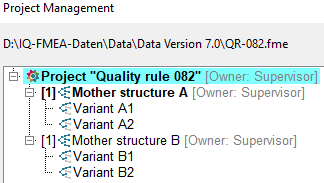
Mother structure A has been defined using the context menu in the project management as the main structure. This is marked in bold. Mother structure A is connected to mother structure B via function links, resulting in structure-spanning function nets. These nets look like this:

The variants belonging to the parent structures were created by removing functions. Thus, the variants A1 and A2 were created from mother structure A by eliminating the functions Fn2-A and Fn1-A, respectively. This is how they look in the FFA Editor:


Variants B1 and B2 of the mother structure B were created by removing the functions Fn2-B and Fn1-B respectively:


- Since both function and failure nets are linked via the parent structures – and not via the variants – the Variants Transition Matrix must be used to determine which variants are connected (associated) with each other. To do this, make sure that the Variant Transition Matrix is activated beforehand via Tools | Workstation Settings | Settings | Application components.
- If the display option “Show NULL variants” is not active, the matrix will look like the following image. This is because there are only four variants in the project “Quality rule 082” and two of them belong to the main structure (here: Mother structure A):
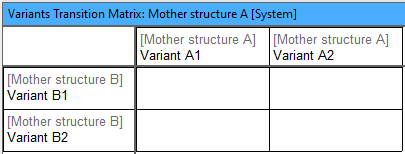
- The following three examples briefly illustrate how the function net for variant A1 changes according to linked information contained in the Variants Transition Matrix. The second image shows how this is displayed in the Project Management.
a)

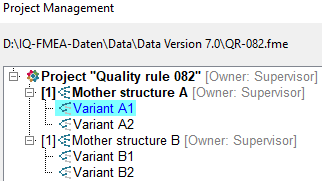

b)
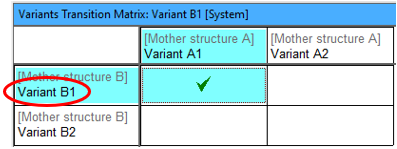


c)
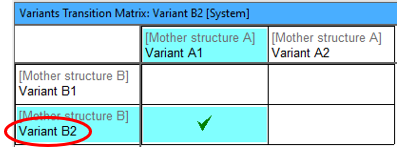


- The results from this Quality Rules are dependent on how the Variant Transition Matrix is filled out. In this example, the Quality Rule identifies seven variant-transition-matrix cases whereby matrix entries are missing. These results are identified from their columns and rows whereby entries need to be made. Using the IQ Explorer, the seven cases are shown below:

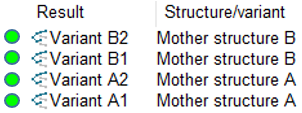
2.
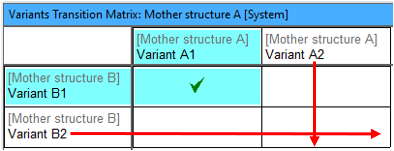

3.
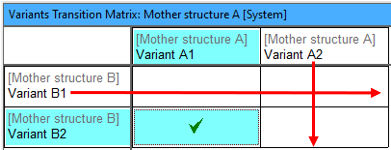

4.


5.
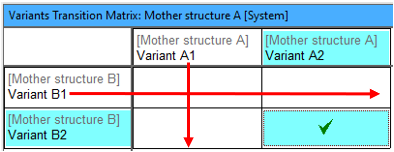

6.

![]()
7.

![]()
Search result: ![]()
In this example, the 4 variants are hits: Variant A1, Variant A2, Variant B1 und Variant B2.